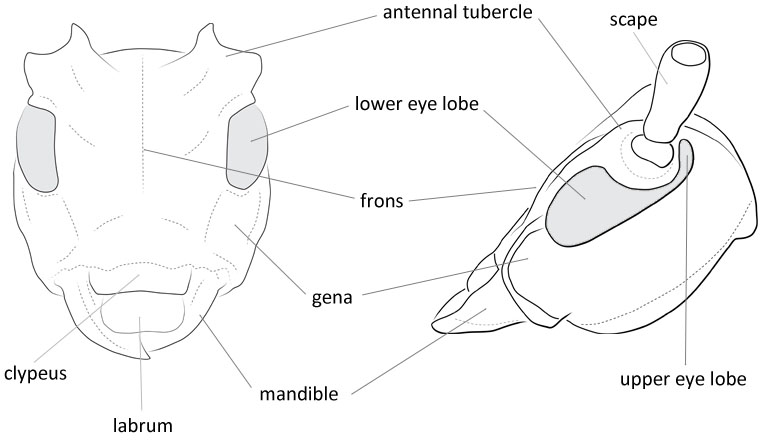Body length: 8–10 mm.
Eyes: eye interommatidial setaeseta:
a sclerotized hair-like projection of the cuticle
usually present and short, eye deeply emarginateemarginate:
notched at the margin > half width, eye ommatidial density coarse.
> half width, eye ommatidial density coarse.
Antennaeantenna:
in larval and adult insects, paired segmented appendages, borne one on each side of the head, functioning as sense organs and bearing a large number of sensilla
: antennal length reaches between basebase:
the part of any appendage or structure that is nearest the body
and end of elytraelytron:
the leathery forewing of beetles, serving as a covering for the hind wings, commonly meeting opposite elytron in a straight line down the middle of the dorsum in repose
or reaching/surpassing end of body, antennal flagellar segments elongateelongate:
much longer than wide
, scapescape:
the first proximal segment of the antenna smooth/punctate at apexapex:
smooth/punctate at apexapex:
end of any structure distad to the base
, antennal scapescape:
the first proximal segment of the antenna ≥ segment 3.
≥ segment 3.
Pronotumpronotum:
the upper and dorsal part of the prothorax
: pronotumpronotum:
the upper and dorsal part of the prothorax
shape subquadratesubquadrate:
not quite a square
, pronotumpronotum:
the upper and dorsal part of the prothorax
lateral armature absent.
Prosternum: prosternal processprosternal process:
a posterior extension of the prosternum between the coxae dilated at apexapex:
dilated at apexapex:
end of any structure distad to the base
, rarely not dilated at apexapex:
end of any structure distad to the base
, procoxal cavities open posteriorly.
Elytraelytron:
the leathery forewing of beetles, serving as a covering for the hind wings, commonly meeting opposite elytron in a straight line down the middle of the dorsum in repose
: elytral length reaching or close to end of abdomen, elytral apicesapex:
end of any structure distad to the base
rounded or truncatetruncate:
cut off squarely at the tip
, elytral color black or brown, elytral color pattern absent.
Legs: visible tarsomerestarsomere:
subdivision or article of the tarsus, usually numbering from two to five : 4, femora slender, rarely clavateclavate:
: 4, femora slender, rarely clavateclavate:
thickening gradually toward the tip
, protibial spursprotibial spur:
sclerotized spine(s) located at the distal tibia; can be single, double, or absent : 2, tarsal clawstarsal claw:
: 2, tarsal clawstarsal claw:
usually paired claws of the pretarsus, at the distal end of the leg simple.
simple.
Form elongateelongate:
much longer than wide
, a little depressed, sides subparallel; pubescence relatively short, intermixed with scattered long, erect setaeseta:
a sclerotized hair-like projection of the cuticle
. Eyes coarsely faceted. Antennaeantenna:
in larval and adult insects, paired segmented appendages, borne one on each side of the head, functioning as sense organs and bearing a large number of sensilla
a little longer than body in male, a little shorter than body in female, segments without spines, ciliate at apicesapex:
end of any structure distad to the base
, third segment shorter than fourth, second and third together shorter than scapescape:
the first proximal segment of the antenna . Pronotumpronotum:
. Pronotumpronotum:
the upper and dorsal part of the prothorax
broadly rounded or subangulate at sides, disk coarsely, densely punctatepunctate:
set with fine, impressed points or punctures appearing as pin-pricks
, without median polished vittavitta:
a broad longitudinal stripe
; anterior coxal cavities broadly angulate externally, intercoxal process thickened but not expanded behind coxae; intermediate coxal cavities open to epimeronepimeron:
the posterior division of a thoracic pleuron, marked anteriorly by the pleural suture . Elytraelytron:
. Elytraelytron:
the leathery forewing of beetles, serving as a covering for the hind wings, commonly meeting opposite elytron in a straight line down the middle of the dorsum in repose
wider at basebase:
the part of any appendage or structure that is nearest the body
than pronotumpronotum:
the upper and dorsal part of the prothorax
at middle, elongateelongate:
much longer than wide
, parallel-sided; apicesapex:
end of any structure distad to the base
rounded, without spines. Legs slender; femora without apical spines. Abdomen with sternites finely, sparsely punctatepunctate:
set with fine, impressed points or punctures appearing as pin-pricks
, fifth shorter than fourth and apically subtruncatesubtruncate:
not quite cut off squarely at the tip
in male, as long as fourth and rounded at apexapex:
end of any structure distad to the base
in female. (Linsley 1962Linsley 1962:
Linsley EG. 1962. The Cerambycidae of North America. Part III. Taxonomy and Classification of the Subfamily Cerambycinae, Tribes Opsimini Through Megaderini. University of California Publications in Entomology, Vol. 20. 188 pp.).
Haplidus, Micranoplium
Can be differentiated from Haplidus by the maxillary and labial palpi being expanded and triangular. Differs from Micranoplium in having the third antennal segment shorter than the fourth and the pubescence short with an intermixture of long erect and suberect setaeseta:
a sclerotized hair-like projection of the cuticle
.
California: Sierra Nevada and Coast Range Mts., coastal southern California south to San Diego County
Pinus spp.
two species
Hesperanoplium Linsley, 1957